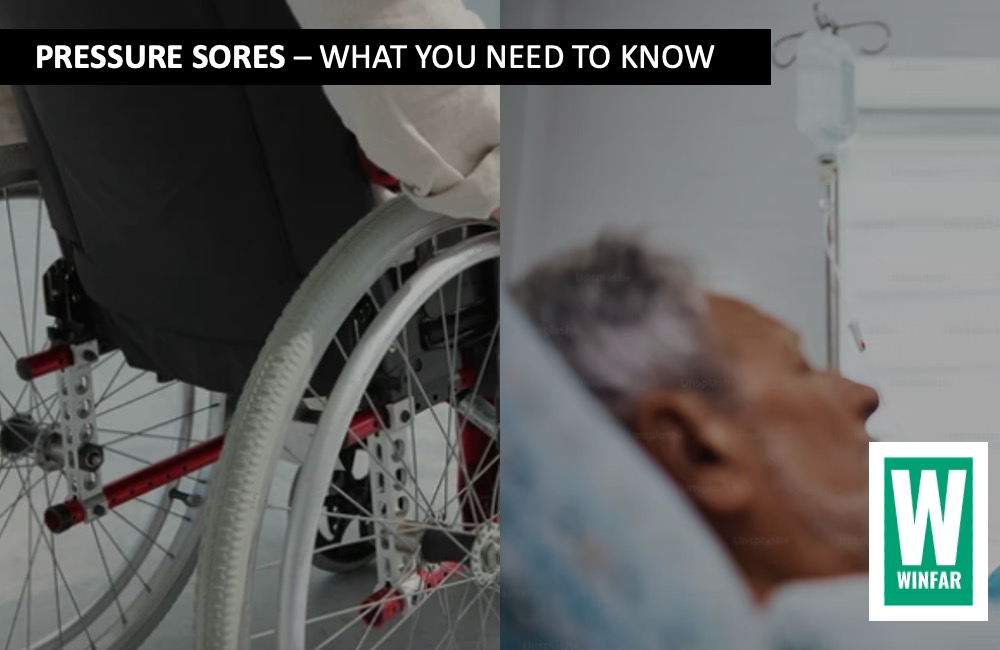Pressure sores also known as bedsores are injuries to the skin, and underlying tissue, primarily caused by prolonged pressure on the skin.
While they can occur in anyone, they most frequently impact individuals confined to prolonged bed rest or those who spend extended hours in chairs or wheelchairs. These sores typically manifest on bony areas such as the heels, elbows, hips, and base of the spine, signalling the need for proactive care and attention.
What is pressure?
‘Pressure’ is a continuous force against a surface or object. For wheelchair users, the seat and backrest are in constant contact with the user’s body.
Shear is a combination of downward pressure and friction. Shear or Shear force occurs in wheelchair users when they move
Microclimate is not a direct cause of pressure sores but it does increase the effects of pressure and shear. Increased skin temperature and moisture will weaken the outer skin layers. The more common causes of microclimate include sweat, incontinence, wound fluid, and sitting on a non-breathable fabric.
What exactly are pressure sores?
Essentially, they are areas of skin subjected to prolonged pressure, resulting in irritation and discomfort.
Early signs may include redness, discolouration, or darkening of the affected skin, with variations depending on individual skin tones.
If left untreated, these symptoms can escalate, leading to hardened, warm-to-the-touch areas characteristic of stage 2 ulcers. Categorically, pressure ulcers span stages from 1 to 4, with the severity increasing as the condition progresses.
Pressure sores, or pressure ulcers, occur due to sustained pressure on specific body regions, often exacerbated by immobility. These areas, commonly near bony prominences such as the hips, back, elbows, and ankles, are susceptible to damage when positional changes are infrequent. Without prompt intervention, these injuries can escalate, potentially fostering severe infections with life-threatening implications. Over time, the toll on skin integrity can result in tissue loss, infections, and, in severe cases, necrosis.
What are the causes of pressure sores?
Understanding the multifaceted causes of pressure sores is crucial.
External factors, include prolonged pressure and friction from ill-fitting equipment or bedding.
Internal factors, include limited mobility, advanced age, chronic illnesses, and compromised blood circulation, and Urinary and fecal incontinence all amplify the risk.
Lifestyle habits like smoking, inadequate nutrition, and dehydration also play a role, underscoring the importance of holistic care approaches.
Preventing pressure ulcers
Recognizing those most vulnerable to pressure ulcers is vital for effective prevention and intervention. Factors such as advanced age, immobility, obesity, incontinence, and certain medical conditions heighten susceptibility.
It can be difficult to completely prevent pressure ulcers, but there are some things you can do to reduce the risk.
These include:
- regularly changing your position – if you’re unable to change position yourself, a relative or carer will need to help you
- Using support surfaces. Use a mattress, bed and special cushions that help you sit or lie in a way that protects vulnerable skin.
- checking your skin every day for early signs and symptoms of pressure ulcers – this will be done by your care team if you’re in a hospital or care home
- having a healthy, balanced diet that contains enough protein and a good variety of vitamins and minerals – if you’re concerned about your diet or caring for someone whose diet may be poor, ask your GP or healthcare team for a referral to a dietitian
- stopping smoking – smoking makes you more likely to get pressure ulcers because of the damage caused to blood circulation
For wheelchair users, tailored strategies are imperative to prevent pressure ulcers. Ensuring the wheelchair’s proper fit, regular assessments, and repositioning are fundamental practices.
Avoiding Pressure Ulcers in Wheelchair
1. Is your wheelchair the proper size and fit?
Factors to consider:
– Amount of mobility
– posture
– discomfort level
– inhibiting conditions
Weight Restrictions:
Measure weight to ensure that desired wheelchair can properly support patient. Also keep in mind the weight of the chair. If you need a chair that can be easily transported, a lightweight design may be more appropriate.
The Seat:
Determine the necessary seat width you will need.
It’s recommended that you measure width of patients hips and then add 2 inches.
Next, you need to find the appropriate depth, measure from the back of the hip to the back of the knees and subtract 1 inch.
The Backrest:
Additional back support can be provided by certain wheelchair designs. Again, assess the intended patient’s condition and necessities to determine most comfortable fit.
**With person seated in wheelchair, measure from collarbone to seat.
The Footrest:
Determine what special features may be needed. Some patients require their legs to be lifted, and there are different size variations based on user’s height.
**Measure from the back of the knee to heel of the foot
The Armrests:
You may not have realised that wheelchairs are available with different armrest and height variations.
**The height of your armrests should be determined by measuring from the elbow to seat of chair with arms up and bent at 90-degree angle
Full-Length -> ideal for having to perform standing or pivoting transfers and provides surface that allows to additional push and support.
Desk-Length -> designed for patients who spend time sitting at a surface or desk, and allow for you to comfortably get closer.
Also read: 7 Keys to Ensuring your chair is correctly setup for you
2. Check for proper fit at leats twice a year
The patient may gain or lose weight over the course of time which can compromise the proper fit.
Take note of any painful areas, and let your doctor know immediately!
3. Repositioning
Shift weight to take pressure off of certain areas and promote blood flow. Leaning forward and side to side are the easiest movements
Caregivers must assist with shift weight every 15-20 mins. We realize that this can be very overwhelming to manage and almost unrealistic
So consider the use of medical aids. Just like bed sores, treatment for pressure ulcers from a wheelchair can be enhanced with the use of alternating pressure pads or cushions.
References:
Mayo Clinic Bedsore Symptoms | Mayo Clinic Bedsore Diagnosis | Karma Medical Bedsores | Hopkins Bedsores | NHS Pressure Sores

